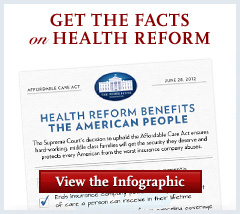A More Secure Future
What the New Health Law Means for You and Your Family
Health Care that Works for Americans
On March 23, 2010, President Obama signed the Affordable Care Act into law, putting in place comprehensive reforms that improve access to affordable health coverage for everyone and protect consumers from abusive insurance company practices. The law allows all Americans to make health insurance choices that work for them while guaranteeing access to care for our most vulnerable, and provides new ways to bring down costs and improve quality of care.
Understanding the Reforms
Here are the key facts about the Affordable Care Act.
Consumer Rights and Protections
In the past, insurance companies could take advantage of you. They could deny coverage to children who had asthma or were born with a heart defect, put a lifetime cap on the amount of care they would pay for, or cancel your coverage when you got sick just by finding an accidental mistake in your paperwork. The Affordable Care Act creates a new Patient’s Bill of Rights that protects you from these and other abusive practices.
End to Pre-Existing Condition Discrimination: Insurance companies can no longer deny coverage to children because of a pre-existing condition like asthma and diabetes, providing peace of mind for parents of the more than 17.6 million children with pre-existing conditions. Starting in 2014, no American can be discriminated against due to a pre-existing condition.
End to Limits on Care: In the past, some people with cancer or other chronic illnesses ran out of insurance coverage because their health care expenses reached a dollar limit imposed by their insurance company. Under the health care law, insurers can no longer impose lifetime dollar limits on essential health benefits and annual limits are being phased out by 2014. More than 105 million Americans no longer have lifetime limits thanks to the new law.
End to Coverage Cancellations: Insurance companies can no longer drop your coverage when you get sick due to a mistake you made on your application.
More Affordable Coverage
The law helps you by bringing down health care costs and making sure your health care dollars are spent wisely. Insurance companies will now be accountable to their customers for how they are spending premium dollars, and how much they are raising rates. Plus, the new law will help lower costs through new tax credits and new marketplaces where insurers will have to compete for your business.

Value for Your Premium Dollar: Thanks to the Affordable Care Act’s 80/20 rule, if insurance companies don’t spend at least 80 percent of your premium dollar on medical care and quality improvements rather than advertising, overhead and bonuses for executives, they will have to provide you a rebate. The first rebates will be made in the summer of 2012.
Stopping Unreasonable Rate Increases: In every State and for the first time ever, insurance companies are required to publicly justify their actions if they want to raise rates by 10 percent or more.
Small Business Tax Credits: Small businesses have long paid a premium price for health insurance – often 18 percent more than larger employers. The tax credit will benefit an estimated 2 million workers who get their insurance from an estimated 360,000 small employers who will receive the credit in 2011 alone.
Better Access to Care
The health care law builds on what works in our health care system. And it fixes what’s broken by providing you with more health insurance choices and better access to care.

Free Prevention Benefits: Insurers are now required to cover a number of recommended preventive services, such as cancer, diabetes and blood pressure screenings, without additional cost sharing such as copays or deductibles. Already, 54 million Americans with private health coverage have gotten better preventive services coverage as a result.
Coverage for Young Adults: Under the law, most young adults who can’t get coverage through their jobs can stay on their parents’ plans until age 26 – a change that has already allowed 3.1 million young adults to get health coverage and given their families peace of mind.
Coverage for Americans with Pre-Existing Conditions: Before the law, many Americans with pre-existing conditions were locked or priced out of the health insurance market. More than 50,000 Americans with pre-existing conditions have gained coverage through the new Pre-Existing Condition Insurance Plan. This temporary program makes health coverage available and more affordable for individuals who are uninsured and have been denied health insurance because of a pre-existing condition. In 2014, insurance discriminating against anyone with a pre-existing condition will be illegal.
Affordable Insurance Exchanges: Affordable Insurance Exchanges are one-stop marketplaces where consumers can choose a private health insurance plan that fits their health needs. Starting in 2014, they will offer to the public the same kinds of insurance choices members of Congress will have. Exchanges will select health plans qualified to offer coverage; facilitate consumer assistance, shopping and enrollment; and coordinate eligibility for the Exchange and potential premium assistance. Already, 33 States and the District of Columbia are on their way to building Exchanges, having received at total of nearly $670 million in Exchange Establishment Grants.
Strengthening Medicare
Nearly 50 million older Americans and Americans with disabilities rely on Medicare each year, and the new health care law makes Medicare stronger by adding new benefits, fighting fraud, and improving care for patients. The life of the Medicare Trust Fund will be extended to at least 2024 as a result of reducing waste, fraud, and abuse, and slowing cost growth in Medicare. And, over the next ten years, the law will save the average person in Medicare $4,200. People with Medicare who have the prescription drug costs that hit the so-called donut hole will save an average of over $16,000.
Lower Cost Prescription Drugs: In the past, as many as one in four seniors went without a prescription every year because they couldn’t afford it. To help these seniors, the law provides relief for people in the donut hole – the ones with the highest prescription drug costs. As a first step, in 2010, nearly four million people in the donut hole received a $250 check to help with their costs. In 2011, 3.6 million people with Medicare received a 50 percent discount worth a total of $2.1 billion, or an average of $604 per person, on their brand name prescription drugs when they hit the donut hole. Seniors will see additional savings on covered brand-name and generic drugs while in the coverage gap until the gap is closed in 2020.
Free Preventive Services: Under the new law, seniors can receive recommended preventive services such as flu shots, diabetes screenings, as well as a new Annual Wellness Visit, free of charge. So far, more than 32.5 million seniors have already received one or more free preventive services, including the new Annual Wellness Visit.
Fighting Fraud: The health care law helps stop fraud with tougher screening procedures, stronger penalties, and new technology. Thanks in part to these efforts, we recovered $4.1 billion in taxpayer dollars in 2011, the second year recoveries hit this record-breaking level. Total recoveries over the last three years were $10.7 billion. Prosecutions are way up, too: the number of individuals charged with fraud increased from 821 in fiscal year 2008 to 1,430 in fiscal year 2011 – nearly a 75 percent increase.
Improving Care Coordination and Quality: Through the newly established Center for Medicare and Medicaid Innovation, this Administration is testing and supporting innovative new health care models that can reduce costs and strengthen the quality of health care. So far, it has introduced 16 initiatives involving over 50,000 health care providers that will touch the lives of Medicare and Medicaid beneficiaries in all 50 states.
Providing Choices while Lowering Costs: The number of seniors who joined Medicare Advantage plans increased by 17 percent between 2010 and 2012 while the premiums for such plans dropped by 16 percent – and seniors across the nation have a choice of health plans.
"The stories of everyday Americans and, more importantly, the courage it took to share those stories is what kept this effort alive and moving forward even when it looked like it was lost. They are why we got this done. They are why I signed this bill into law."
Reform by State
Find out what's happening in your state and listen to stories from Americans across the country.
 View the Map
View the Map









